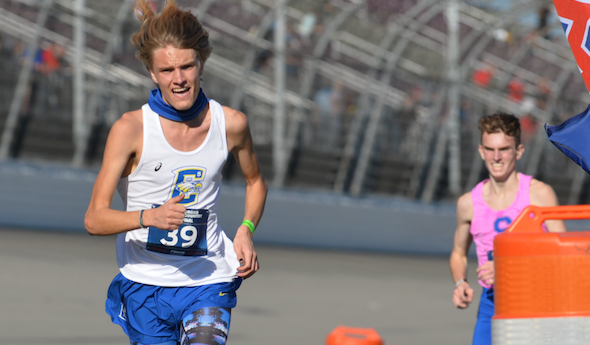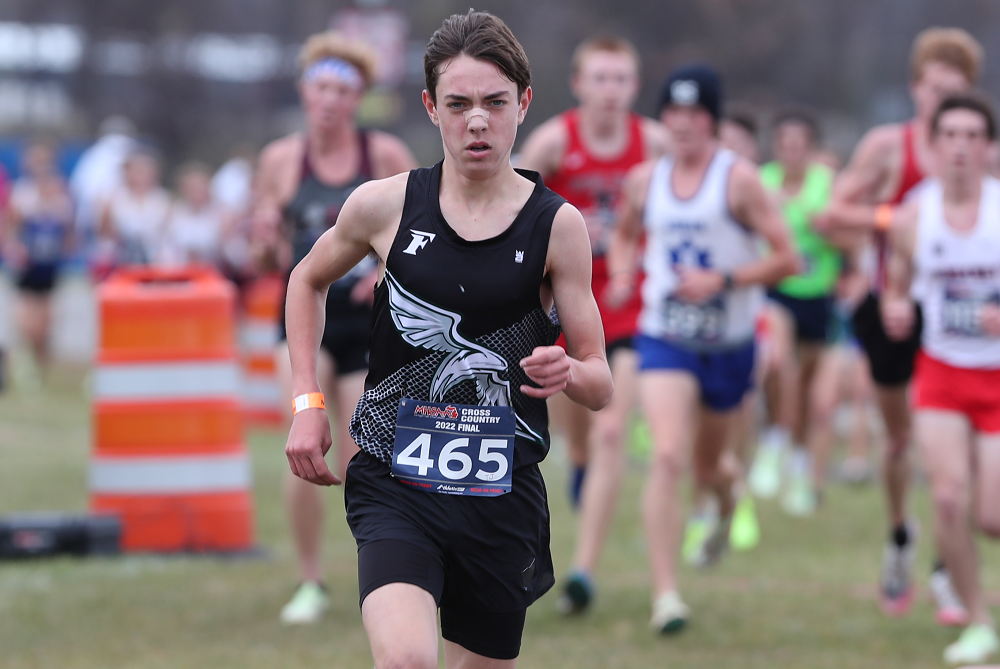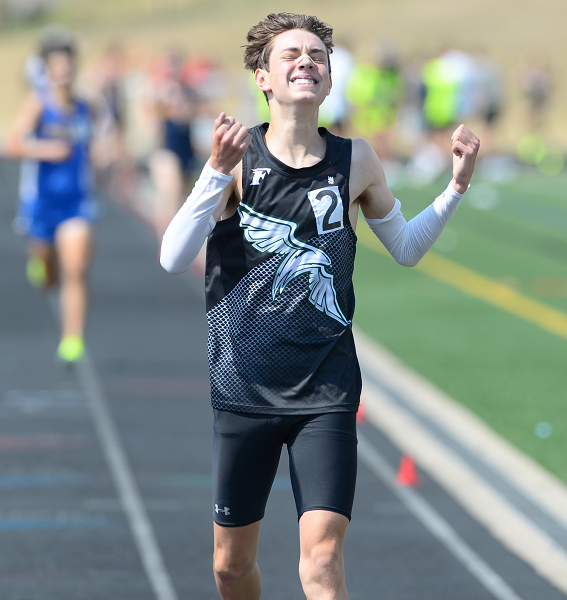
Carson City-Crystal Earns Finals Sweep
November 7, 2020
By Jason Schmitt
Special for Second Half
BROOKLYN – When Carson City-Crystal’s Coleman Clark crossed the finish line Saturday, he raised his arms over his head and belted out a loud scream.
He had plenty of reasons to celebrate.
The senior captured the Division 4 individual title at the MHSAA Lower Peninsula Boys Cross Country Finals, beating out a loaded field in the second of two races in the division. He broke 16 minutes, finishing in 15:58.55.
And his Eagles also captured the school’s first boys cross country team title since 1994.
“My goal was to come in here and win it,” said Clark, who finished runner-up to Breckenridge’s Mason Sumner a year ago. “And to have my team win as well, this is awesome.”
Clark said his strategy was to take an early lead and keep it. That’s what he did.
“Throughout the race, it could have been anybody’s. But once I got to the stretch, I knew I was going to win it,” he said. “This is the strongest front pack we’ve had in a long time. There were a lot of top runners up there. I’m friends with a lot of them. I race them all the time.
And to break 16. It feels great, amazing.”
Saugatuck junior Max Sharnas finished runner-up in a time of 16:06.51. Sumner finished third (16:31.27), while Mount Pleasant Sacred Heart senior Matthew Nowak finished fourth and Petoskey St. Michael Academy junior Samuel Paga fifth overall.
 As a team, Carson City-Crystal was solid one through five. Junior Ashton Keiffer finished 25th overall, earning all-state honors after running a time of 17:38.74. Also scoring for the Eagles were sophomore Brayden Clark and seniors Jared Shepler and Calvin Clark.
As a team, Carson City-Crystal was solid one through five. Junior Ashton Keiffer finished 25th overall, earning all-state honors after running a time of 17:38.74. Also scoring for the Eagles were sophomore Brayden Clark and seniors Jared Shepler and Calvin Clark.
“In past years, we haven’t had a super, great team,” Clark said. “This year, we’ve got the most amazing, talented group of guys I’ve ever raced with. I knew that we could pull off a state title if we worked hard.”
Head coach Grant Woodman knew a championship would not come easy. But when he learned his team had accomplished the feat, he was more than fired up.
“It’s pretty freaking awesome,” the coach said, still somewhat in disbelief. “Our history at the school is pretty steeped with tradition, so to bring a state title back is pretty cool.
“We knew it was going to be a fight from the beginning. Saugatuck, Breckenridge and Webberville, we’ve been fighting back and forth with those teams all season. Breckenridge is in our league, and we’ve been keeping an eye on Saugatuck on the other side of the state. They are a powerhouse every year.
Carson City-Crystal’s last Finals team title came back in 1994, the same year the school last produced an individual state champion (Justin Curry).
Breckenridge finished runner-up, led by Sumner’s third place. Also earning all-state honors for the Huskies were junior Trent Carter (8th place) and Colttion Vine (20th place).
Concord was third overall, followed by Kalamazoo Christian and Saugatuck in the top five.
PHOTOS: (Top) Carson City-Crystal’s Coleman Clark digs for the final paces of his Division 3 Finals heat with Saugatuck’s Max Sharnas just behind. (Middle) Ashton Keiffer was the second Eagles runner to cross Saturday. (Click for more from RunMichigan.com.)

Freeland's Hansen Not Focused on Joining All-Time Greats - But On His Way
By
Paul Costanzo
Special for MHSAA.com
September 29, 2023
The goal written on Matt Kaczor’s Post-It Note was sub-15 minutes, 15 seconds. That’s what the Freeland cross country coach was hoping for from star runner TJ Hansen during his junior season.
 Kaczor tore it up after seeing Hansen run a single race this fall.
Kaczor tore it up after seeing Hansen run a single race this fall.
“Knowing what he did over the summer and where he was at, seeing what his 1,600 (meter) and his mile got down to, I had a feeling he could get under 15:30 quickly,” Kaczor said. “After the first race, I looked at my assistant and was like, ‘I’ve gotta rip up that Post-It Note. I don’t think our goal is on the level of where he’s at right now.’ At first, it was break 15:15. Once I saw him race at the Under the Lights (on Aug. 18 at St. Johns), I was like, ‘Yeah, he’s going sub 15.’”
Hansen ran 15:39.6 in that first race, and on Sept. 7, in Shepherd, he ran 15:13.9 to meet the goal written on the now-shredded Post-It Note.
This past Saturday, he ran 15:03.7 at the Cadillac Veterans Serving Veterans Invitational. It’s the fastest time recorded in Michigan this year, and a signal that Kaczor might be filling out a new Post-It Note before the season is out.
“The sub-15 barrier, that’s been something on my mind for a while,” Hansen said. “Now that I’m edging closer and closer to that, it’s been exciting. With how heavy my training has been, I wouldn’t expect (to have run this fast this early). Being able to run the times I am really paints the picture for what’s ahead.”
Hansen came into the season already regarded as one of the elite distance runners in the state. He won the 3,200 meters at the MHSAA Lower Peninsula Division 2 Track & Field Finals this past spring. He’s also finished all-state (12th and fifth, respectively) the past two seasons at the LPD2 Cross Country Finals.
His current trajectory, however, would put his name near some of the state’s all-time greats. But that’s not something Hansen is focusing on.
“I really don’t like to compare myself to others,” he said. “I don’t focus on that. I try to be the best TJ Hansen that I can be. The best version of myself.”
Focusing on himself is almost necessary for Hansen, as he’s spending a lot of time during his races running by himself.
At each of the big events Freeland has run in this season, Hansen has finished at least 20 seconds ahead of his nearest competitor. That includes all divisions of the Duane Raffin Festival of Races in Holly.
In Cadillac, where Hansen ran his current best time, he was a full minute ahead of the rest of the field.
 “He’s just a special athlete,” Kaczor said. “I can’t see Freeland having someone like this in a while. He’s a generational talent. What’s crazy is, I had the school record when he was a freshman. He and Braden (Honsinger) broke it last year. But TJ has now dropped that school record (set in 1998) by almost a minute.”
“He’s just a special athlete,” Kaczor said. “I can’t see Freeland having someone like this in a while. He’s a generational talent. What’s crazy is, I had the school record when he was a freshman. He and Braden (Honsinger) broke it last year. But TJ has now dropped that school record (set in 1998) by almost a minute.”
Hansen’s achievements have already put him on a path to run at the next level, which is something of a family tradition.
His older sisters Peyton and Kiera are track & field athletes at Wayne State and Eastern Michigan, respectively. Their parents, Tim and Pam, were track & field stars at Central Michigan.
TJ has drawn the attention of coaches around the country, including from Michigan, Michigan State, Wisconsin, Tennessee and Colorado.
Having family members who know the process is a help for Hansen, and he said they’ve all been good about allowing him to choose his own path, whatever that may be.
“He’s from a good family that knows how to work and knows how to get things done,” Kaczor said. “He knows that if he puts in the work, he’s going to be at a good spot.”
While Hansen admits it can be a bit overwhelming, he’s using it as motivation to run faster and continue to put his name out there.
Also serving as motivation is 2022 Division 2 champion Connell Alford of Chelsea. Alford is among the elite group of runners in Michigan who have broken the 15-minute mark, doing it twice a year ago.
He currently has the state’s second-best time behind Hansen’s this year, running 15:09.1 at the MSU Invitational on Sept. 15.
“Whenever I see him drop a time, my main goal is to run faster,” Hansen said. “Whenever I see him run a good time, that motivates me to work hard.”
The two won’t see each other until the MHSAA Finals on Nov. 4 at Michigan International Speedway. It’s an opportunity Hansen is excited for, as it’s a chance to race and be pushed toward the lofty goals he’s set for himself. Kaczor is excited about it, too, even if it might mean having to replenish his supply of Post-Its.
“We don’t talk about winning the state title; we talk about making sure that we have great races on those days,” Kaczor said. “We can’t control how somebody else runs. It’s a matter of can we, if the weather is right and the course is in good condition, can we be one of the few guys that has run in the 14s on that course? That’s the goal. Put yourself in some great categories with those upper echelons and the greats of all-time.”
 Paul Costanzo served as a sportswriter at The Port Huron Times Herald from 2006-15, including three years as lead sportswriter, and prior to that as sports editor at the Hillsdale Daily News from 2005-06. He can be reached at [email protected] with story ideas for Genesee, Lapeer, St. Clair, Sanilac, Huron, Tuscola, Saginaw, Bay, Arenac, Midland and Gladwin counties.
Paul Costanzo served as a sportswriter at The Port Huron Times Herald from 2006-15, including three years as lead sportswriter, and prior to that as sports editor at the Hillsdale Daily News from 2005-06. He can be reached at [email protected] with story ideas for Genesee, Lapeer, St. Clair, Sanilac, Huron, Tuscola, Saginaw, Bay, Arenac, Midland and Gladwin counties.
PHOTOS (Top) Freeland's TJ Hansen leads a pack during last season's LPD2 Final at Michigan International Speedway. (Middle) Hansen enjoys a moment of exhilaration after winning the 3,200 this spring at the LPD2 Finals at Ada Forest Hills Eastern. (Top photo by Carter Sherline/Run Michigan; middle photo by Dave McCauley/Run Michigan.)

